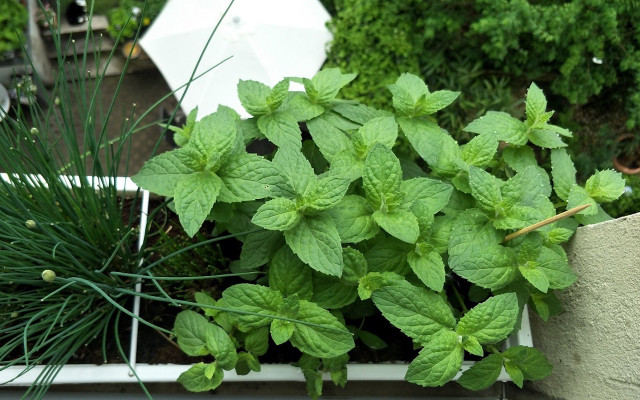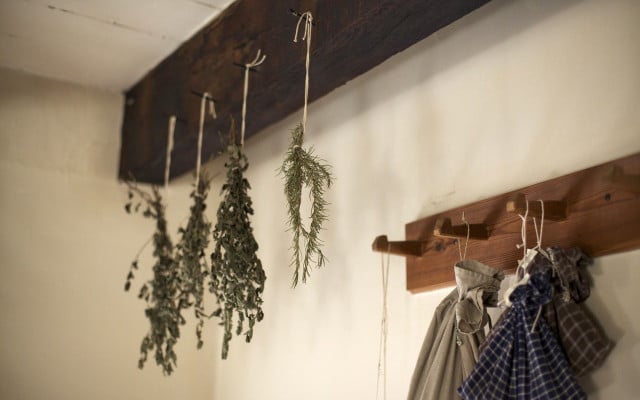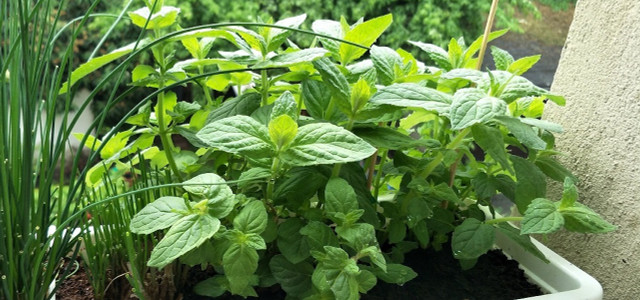Growing mint is easy and rewarding, and because mint plant care is so minimal and effortless, it can be done in almost any setting. In this article, we’ll give you some easy tips and tricks to help you learn how to grow and harvest mint most effectively.
Growing Mint: Planting
Because mint is so hardy, you can plant it almost anywhere. It will grow just as well in your herb garden in the backyard as it will in a pot on the terrace or balcony. Due to its long roots that spread out underground, mint grows tenaciously once in the ground, and you will find yourself having to ensure that it does not crowd out your other plants.
Mint can also easily be grown indoors, and with enough warmth and sunlight, will continue to grow all winter long. If you do choose to grow your mint outdoors, with the proper care, this perennial plant will return each spring without you having to lift a single finger.
The ideal environment for growing mint includes:
- Full sun to half shady
- Moist but well-drained soil
- Sandy, mineral-rich earth with a good amount of humus
- At least 6×6 inches of space
- No chamomile plants in the area (chamomile and mint will compete for nutrients and interfere with one another’s growth).
Make sure that the mint has enough room to grow up to about three feet tall. In the beginning, the thin stem of the mint plant will grow along the ground and then upwards. With time, new and stronger stems wills grow, which will bring with them larger, more aromatic leaves. Despite growing to a considerable height, mint is still a very good balcony plant.
Good mint plant care involves regular trimming, which you’ll want to do anyway to make use of the leaves. Frequent harvesting prevents the mint plant from expanding too much and growing out of control.
How to Grow Mint in the Garden: When to Plant

The ideal time for planting mint is from April until June. By this time, the frost will have passed and the young plant will have the whole summer to grow and thrive. You can also plant mint in July or August, but if you wait any longer the mint will not have a chance to develop well. Immediately after transplanting the newly germinated seedlings into the earth, be sure to water them generously and keep the ground moist, but well-drained.
Tip: The roots of the mint plant will spread out extensively underground and try to steal nutrients from any plants that might be near it. For this reason, some sort of root-block is advisable; for example, plant the mint in a pot and then simply place the entire pot in the earth – or on your kitchen windowsill.
Mint Plant Care: Fertilizing and Trimming



- Watering: On warm summer days, watering your mint plant is a must. Pay attention to how much it has rained – if there has been no precipitation in the past few days, be sure to give your plant some hydration.
- Fertilizing: It is not necessary to use any special fertilizer when growing mint. If you like, simply shovel a bit of compost over the roots in spring before it begins to grow in the new year.
- Trimming: By regularly trimming the mint plant, you encourage new growth. In a few days, your plant will have new and noticeably larger and more aromatic leaves.
- Care for the Soil: Your mint plant is constantly pulling nutrients out of the ground, causing the soil to become alkaline after a few years.To combat this, it’s a good idea to transplant the mint every three to five years and add compost and fertilizer to the area where it once was, to re-enrich the soil.
- Propagate: Mint blooms between June and September. To seed new plants, take cuttings from what is left of the plant after it blooms and replant. The new plants will spread out quickly, so be sure to leave them enough space to grow.
- Prepare for Winter: In autumn, cut the mint as closely as possible to the ground. This way, the plant will easily survive the winter and will grow back in the spring.
Growing Mint: Harvesting and Drying Mint Leaves



Mint has long been used as an herbal remedy. It is valued for its cooling properties, and has been used to relieve headaches, clogged sinuses, and menstrual cramps for thousands of years. It can even be used as a sleeping aid.
In addition to its medicinal properties, mint also has a wide variety of culinary uses. It is the perfect addition to cocktails or lemonade in summer, or to add a refreshing note to pastas, soups, or salads. Mint leaves are best harvested on summer mornings, but can be cut or picked any time between spring and autumn.
- To harvest large amounts of mint, cut the entire plant close to the ground in June. It will grow back so quickly that you will be able to re-harvest the whole plant again in August.
- If you need only a small amount of mint, for tea or for drinks in the summer, cut off a few 5-8 cm stems off at a time.
If you want to have mint all winter long, you can dry the leaves and store them. It is best to do this immediately after harvest and without exposure to sunlight as this will cause the flavor and many chemical constituents to be diminished. Tie the mint in a bunch and hang in a warm, non-humid, shady place and allow it to dry in the air.
This article was translated from German to English by Christie Sacco. You can read the original here: Pfefferminze pflanzen und pflegen – im Garten oder auf dem Balkon
** Links to retailers marked with ** or underlined orange are partially partner links: If you buy here, you actively support Utopia.org, because we will receive a small part of the sales proceeds. More info.Do you like this post?






